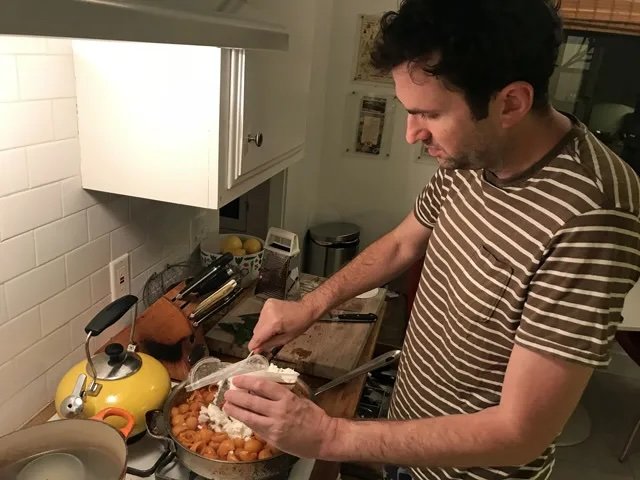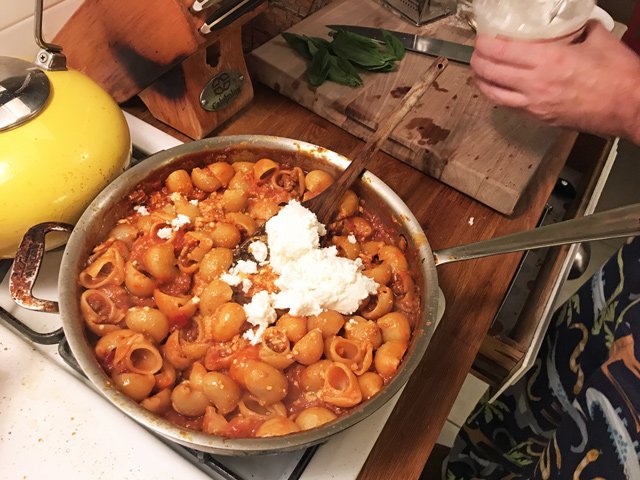You Know You Want To Stir Ricotta Into Your Pasta
You’re going to start calling me a broken record on here. In fact, me saying that “I’m a broken record on here” feels like something I’ve said before.
Essentially, I’m going to hit a few of the same themes in this post I’ve been hitting lately: (1) watching cooking shows on PBS; (2) going to McCall’s Meat and Fish. Let’s start with PBS. I watch all of the cooking shows on PBS to get ideas and recently I was watching one I’ve never watched before, Nick Stellino’s show. He’s a jovial Italian man who speaks with a thick Italian accent and with lots of enthusiasm for the food he makes. Recently, he was extolling the virtues of his wife’s pasta. Her trick? She stirs ricotta in at the end. I made a mental note to try that someday. That someday happened on Tuesday night.
I went to McCall’s (actually, looking at my recent posts, I don’t think I’ve mentioned McCall’s, so maybe I’m not a broken record) (oh wait, I mentioned it in the Fun with Chiles post, I am a broken record) and picked up sausage and pasta and canned tomatoes. To be honest, I didn’t go to McCall’s with the idea of buying ricotta to stir into my pasta, but while I was there, I saw that they had nice ricotta so I bought a container and brought it home along with everything else. Of course I paid first. I’m not a thief, geesh!
Not to toot my own horn too much, but this pasta that I made would’ve been pretty incredible even without the ricotta. I started by browning a pound of sausage meat in olive oil:
Then I did as Lidia Bastianich teaches on PBS (here we go again!) and created a “hot spot.” That’s where you push everything aside and create little areas in the oil to cook the other things you’re adding. In this case: sliced garlic and red chile flakes.
Once toasted, stir that all together and add a good splash of red wine.
Confession: I should’ve added tomato paste to the hot spot too, so it could toast, but I forgot to do that. So I added that along with the wine. It’s OK, it’s all going to be fine.
Once that all cooked down, I added a can of cherry tomatoes.
Then it’s all about timing. You want to cook your pasta for a minute or two less than the package directions while making sure your sauce doesn’t get too crazy thick. Keep the heat on low once it’s saucy.
Then you marry everything by dropping the almost-cooked pasta in with the sauce and adding a ladleful of pasta water.
Cook that all together on high heat until the pasta’s taken in as much sauce as possible and the bottom of the pan is relatively dry when you drag your spoon across it.
Now’s the fun part… bring on the cheese!
First I added some grated Pecorino for flavor. I didn’t have that much Pecorino, so don’t think I’m stingy. I just didn’t have it.
Finally, it was time to add the ricotta. I thought Craig would get a kick out of doing that (he loves cheese) so I summoned him to the kitchen and had him conduct the grand finale.
(Aren’t his pajamas cute? I got them in Australia.)
OK, let’s zoom in close so you can see how good it is to add ricotta to your pasta.
OK, that’s pretty sloppy looking, but look how nice once I added basil…
This was all so excellent; sort of like a deconstructed lasagna. As Nick Stellino puts it, adding ricotta is like adding cream but not as rich and fatty. So there’s a lightness to the creaminess. I agree. Adding ricotta is a wonderful thing to do to your pasta, which is why I wrote this post. Now try it!
















